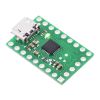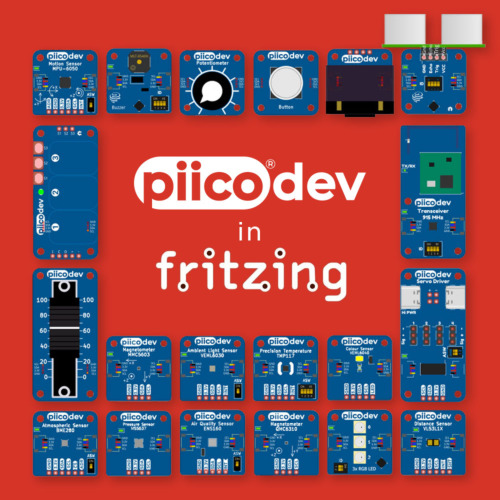CP2102N USB-to-Serial Adapter Carrier
In stock, ships same business day if ordered before 2PM
Delivered by Tue, 13th of Jan
Quantity Discounts:
- 10+ $23.35 (exc GST)
- 25+ $22.62 (exc GST)
 |
|
CP2102N USB-to-serial adapter carrier, bottom view with dimensions. |
|---|
This USB-to-serial adapter is a breakout board for the Silicon Labs CP2102N USBXpress USB-to-UART bridge, and it is a great solution for connecting microcontroller projects and other logic-level serial devices to a personal computer. The tiny unit measures only 0.6" × 0.95" including its Micro-USB connector. It offers several options for accessing the data, control, and GPIO pins on the CP2102N, all of which are made available on a 0.1" spacing.
This board uses 3.3 V signal levels by default, but the signal pins can tolerate higher voltages, allowing the adapter to be used with 5 V systems that see 3.3 V as a logic high. The green LED on the SUSPEND line indicates an active USB connection when lit.
The adapter looks like a standard virtual serial port (COM port) to the computer’s operating system, which means it can be used with any software designed to work with a serial port (even a legacy RS-232 port). The CP2102N is a full-speed USB 2.0 device and allows baud rates of up to 3 Mbps. Drivers are available from Silicon Labs for Windows XP, Windows Vista, Windows 7, Windows 8, Windows 10, Linux, and Mac OS X.
This product requires a USB A to Micro-B cable (not included) to connect to a computer.
If you do not need access to all of the serial control signals, consider the Pololu USB AVR Programmer v2.1 as an alternative. In addition to its functionality as an AVR programmer, it can be used as a USB-to-TTL serial adapter with two configurable serial handshaking lines and support for both 3.3 V and 5 V operation.
For most applications, this CP2102N carrier can be considered a drop-in replacement for Pololu's older CP2104 USB-to-Serial Adapter Carrier with a few improvements like a higher maximum baud rate and re-programmable configuration ROM.
Specifications
- Dimensions: 0.6" × 0.95" including connector
- USB standard: USB 2.0 (full speed)
- Connector: USB Micro-B
- Logic voltage level: 3.3 V (5 V tolerant)
- Supported baud rates: 300 bps to 3 Mbps
- Supply current: 15 mA
Using the adapter
Pinout
| Pin | Type | Function |
|---|---|---|
| VDD | Power | 3.3 V voltage regulator output |
| VBUS | Power | USB bus voltage (5 V) |
| GND | Power | Ground |
| RST | In | Device reset |
| TX | Out | Asynchronous serial data transmit (idle high) |
| RX | In | Asynchronous serial data receive |
| CTS | In | “Clear to send” control input (often used with RTS) |
| RTS | Out | “Ready to send” control output (often used with CTS) |
| DSR | In | "Data set ready" control input (active low) (often used with DTR) |
| DTR | Out | "Data terminal ready" control output (active low) (often used with DSR) |
| DCD | In | "Data carrier detect" control input (active low) |
| RI | In | "Ring indicator" control input (active low) |
| SUSPEND | Out | Driven high when in USB suspend state |
| SUSPEND | Out | Driven low when in USB suspend state (connected to green LED) |
| GPIO.0 | I/O | User-configurable inputs or outputs |
| GPIO.1 | ||
| GPIO.2 | ||
| GPIO.3 |
Connections
All of the adapter’s pins are available in two rows spaced 0.5" apart along the sides of the board. This allows any pin to be accessed easily while the adapter is plugged into a solderless breadboard, as shown in the left picture below.
Alternatively, a 1×6 header can be soldered to the end of the board, as shown in the right picture below. This gives access to six signals (RTS, RX, TX, VBUS, CTS, and GND) that are commonly found on FTDI cables and other similar USB-to-serial adapters. As a result, this CP2102N adapter board can be used as a drop-in replacement for an FTDI cable in many applications, such as programming Arduino-compatible boards.
|
|
The carrier board ships with a 1×25 straight male header strip, a 1×6 right-angle male header strip, and a 1×6 right-angle female header as shown below. You can also solder wires directly to the pads for the smallest installation.
 |
Using a different VIO
 |
This carrier board connects the VIO pin of the CP2102N to VDD by default, setting its logic voltage level to the 3.3 V provided by the IC’s built-in voltage regulator. If you want to use a lower logic voltage, you can disconnect VIO from VDD by cutting the thin trace between the two pads of the surface-mount jumper shown to the right. You can then solder a thin wire to the exposed via labeled “VIO” and connect it to a separate voltage supply (as low as 1.71 V).
Warning: Pololu do not recommend externally supplying VIO to this board while it is not connected to USB, as this can cause it to draw excessive current (up to a few hundred milliamps).
Schematic diagram
 |
This schematic is also available as a downloadable PDF (169k pdf).
Advanced features
You do not need to be familiar with details of the CP2102N to use this board as a basic USB-to-serial adapter, but the CP2102N also has specialized features including four general-purpose I/O (GPIO) pins and the ability to be customized by configuring its internal EEPROM. For advanced users interested in these features, Pololu recommend careful reading of the CP2102N datasheet (619k pdf). Additional resources, including application notes referenced by the datasheet, can also be found on the CP2102N product page on the Silicon Labs website.
Dimensions
| Size: | 0.6" × 0.95" × 0.17"1 |
|---|---|
| Weight: | 1.4 g2 |
General specifications
| Baud: | 300 bps–3 Mbps |
|---|
Identifying markings
| PCB dev codes: | usb03b |
|---|---|
| Other PCB markings: | 0J13036 |
Notes:
- 1
- Without included optional headers. This measurement includes the USB Micro-B connector, which extends 0.05" past the edge of the PCB.
- 2
- Without included optional headers.
File downloads
-
CP2102N datasheet (619k pdf)
-
Schematic diagram of the CP2102N USB-to-serial adapter carrier (169k pdf)
-
Dimension diagram of the CP2102N USB-to-Serial Adapter Carrier (248k pdf)
-
3D model of the CP2102N USB-to-Serial Adapter Carrier (5MB step)
-
Drill guide for the CP2102N USB-to-Serial Adapter Carrier (32k dxf)
This DXF drawing shows the locations of all of the board’s holes.
Recommended links
-
CP210x USB-to-UART bridge drivers
Drivers for CP210x USB-to-UART bridge ICs on the Silicon Labs website.
-
Silicon Labs CP2102N USBXpress USB bridge product page
Product information, including documentation, application notes, and configuration software, for CP2102N USBXpress USB bridge ICs on the Silicon Labs website.
Exact shipping can be calculated on the view cart page (no login required).
Products that weigh more than 0.5 KG may cost more than what's shown (for example, test equipment, machines, >500mL liquids, etc).
We deliver Australia-wide with these options (depends on the final destination - you can get a quote on the view cart page):
- $3+ for Stamped Mail (typically 10+ business days, not tracked, only available on selected small items)
- $7+ for Standard Post (typically 6+ business days, tracked)
- $11+ for Express Post (typically 2+ business days, tracked)
- Pickup - Free! Only available to customers who live in the Newcastle region (must order online and only pickup after we email to notify you the order is ready). Orders placed after 2PM may not be ready until the following business day.
Non-metro addresses in WA, NT, SA & TAS can take 2+ days in addition to the above information.
Some batteries (such as LiPo) can't be shipped by Air. During checkout, Express Post and International Methods will not be an option if you have that type of battery in your shopping cart.
International Orders - the following rates are for New Zealand and will vary for other countries:
- $12+ for Pack and Track (3+ days, tracked)
- $16+ for Express International (2-5 days, tracked)
If you order lots of gear, the postage amount will increase based on the weight of your order.
Our physical address (here's a PDF which includes other key business details):
40 Aruma Place
Cardiff
NSW, 2285
Australia
Take a look at our customer service page if you have other questions such as "do we do purchase orders" (yes!) or "are prices GST inclusive" (yes they are!). We're here to help - get in touch with us to talk shop.
Have a product question? We're here to help!
Guides
The Maker Revolution
Projects
Pico-Dog Motion Activated Audio Alarm
WaveJumper: Music Sample Slicer on a Breadboard
PiicoDev Ecosystem In Fritzing
Makers love reviews as much as you do, please follow this link to review the products you have purchased.

















Product Comments